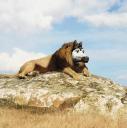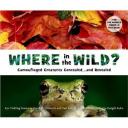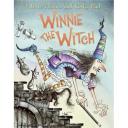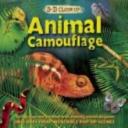This blog provides links to books, interactive kids’ websites, and teaching resources that would be useful in covering the topic of Camouflage in the classroom. The links provided would be appropriate to use with grades ranging from kindergarten to third grade. Many of the sites provided include audio, so if the children are still working on learning to read, they will still understand what to do. Both the books and the websites provide excellent realistic imagery to give the students a clear visual of what camouflage is. Detailed lesson plans can be found in the teacher resources section of the blog. The information provided on this topic covers parts of the following VA Science SOLS: (1.5, 2.7, 3.4)
Literature
Where in the Wild?: Camouflaged Creatures Concealed…and Revealed, By: David Schwartz and Yael Schy, Illustrated by: Dwight Kuhn
From kindergarten age children to parents and teachers, this book is guaranteed to intrigue the reader from page one. Through creative shape-poetry and captivating photography, the reader is challenged to unmask the hidden creatures in the images. This book provides very realistic images, giving the reader a clear representation of what camouflage really looks like. Additionally, the book also includes facts about the animals that are hidden in the pictures. With these facts, the poetry, and the photography, readers are equipped with several tools to help them reveal the hidden creatures.
Winnie the Witch, By: Valerie Thomas and Illustrated by: Korky Paul
This fun Halloween story is about a witch named Winnie and her black cat, Wilbur. Everything in Winnie’s house is black,including Wilbur. Problems begin when Wilbur closes his green eyes to take a nap and Winnie can not see him at all. Winnie ends up tripping over and stepping on Wilbur several times. In an effort to help both herself and her cat, Winnie changes Wilbur into various colors other than black in order to see him better. However, each color seems to create more problems for Winnie and Wilbur. The colorful Wilbur attempts to escape and hide in the top of a tree from Winnie. In the end, Winnie’s love for her cat leads her to change him back to black.
Animals in Camouflage, Written and Illustrated by: Phyllis Limbacher Tildes
The pages of this non-fiction book are filled with seven different animals. These animals are hidden from their predators in large colorful pictures. Children are encouraged to use both the pictures and the written clues to determine where the animal is located. At first, the reader tries to guess where the animals is. Once they turn the page, the reader will discover what animal is hidden within the page. This book provides a colorful representation of camouflage, blending, color change, disguise, and pattern. Additionally, more facts are included at the end of the book about the animals that were discovered.
3-D Close up: Animal Camouflage, By: Daniel Gilpin
This book is filled with mesmerizing close-up photography, artwork, and engaging text. This book also includes four 3-D pop-up cross sections that portray animals with and without their disguises. The reader will learn why some animals need to hide and some do not and how they manage to do it. Some of the camouflaged animals the reader will learn about are zebras, cuttle fish, and clouded leopards.
The Mixed-Up Chameleon, By: Eric Carle
This book by Eric Carle, tells the story of a Chameleon who is not satisfied with blending into his surroundings. After noticing a zoo, he sees all the wonderful animals and begins to wish for various characteristics of all the animals. (“I wish I was tall like a giraffe.”) After receiving all of his wishes, the chameleon ends up being a combination of several different animals that does not really work well all together. The chameleon realizes this when he tries to eat a fly but can not reach it. Upon realizing this, the chameleon wishes to return back to himself again.
Interactive Kids Websites
At this website, children are given the opportunity to navigate through four different habitats: Coral Reef, Rain Forest, African Grassland, and Arctic Meadow. After choosing and clicking on a habitat, the child is able to participate in a hidden animal search. Each of the habitats represents various species using camouflage in different ways.
If You Can’t Run, You’ve Got To Hide!
The first activity on this website the children can take part in is a “Where is Waldo” game. They are given two pictures where the character Waldo is hidden. They must “test their predator skills” and try to find Waldo in both pictures. Further down on the page there are three pictures of real animals using camouflage in their habitats. The child is challenged to try and find the animal in the picture. Lastly, the child is given a representation of comparing and contrasting the habitat that would be safest for a hare. They are given two pictures with a hare, one in the white snow and one in the forest.
This is a great interactive site for kids to play around with different forms of camouflage on both predators and their prey. At this site, kids choose between either a predator or prey. Then, they are instructed to choose a background for their animal: jungle, plains, or tundra. After this, they can choose different fur colors (white, tawny, or dark), shadings (under or counter), and patterns (spots or stripes) to best fit their animal in that habitat.The child can reset the screen and start over at anytime and experiment with different habitats and animals.
This interactive site gives children several different activities to experiment with. The first activity is a short cartoon movie where kids watch and learn about Annie and Moby’s quest to learn more about camouflage. The child will learn with Annie and Moby about how both predators and their prey use camouflage, why what animals change color, why some animals change colors in different seasons, and how animals confuse other animals. Another activity the children can access from this site is drawing an animal camouflaged in its habitat. They can use crayons of different colors and erasers located on the site. Kids can make up an imaginary animal that uses camouflage. The are instructed to name their animal and describe how they use camouflage to survive in their environment. Kids can also fill out a KWL chart about camouflage in the “talk about it” section on the site. Additionally, kids can play with the word wall that provides interactive index cards that have a word on one side and definition on the other. Another activity is the hidden animals game. Kids are given four different habitats and are challenged to find three hidden animals in each. Everything on this site is read aloud to the child. All the child needs to do is roll the mouse over the text and the computer will read off the directions.
This is another great site where kids have the opportunity to play a game where they have to spot the animal that is hidden by camouflage. Once the child thinks they have found the animal, they click on it and after clicking on the correct animal they are given a quick fact about the animal. They can do this activity with several different animals including: lizards, bears, rabbits, snakes, foxes, turtles, owls, amphibians and more!
Additional Teacher Resources
This site provides four different activities to implement into a camouflage lesson plan. One great activity to do with students is the “Hunting Like a Hawk” game. This game portrays the idea that sometimes, even camouflage can fail with sudden movements from the prey. Other activities at this site include: Hiding in the habitat and Hide and Seek. These games are a great way for the students to have a hands-on experience of camouflage. This site also provides teaching advice on: blending, pattern, disguise, and mimicry.
This site provides a lesson plan teaching students how color can help animals in the wild. In the activity in the lesson plan, students go outside and try to find as many toothpicks that the teacher scattered around as possible. When they come back inside they discuss why some colors were found more than others (ex: green). Students will also create a polar bear painting on white paper to depict how its fur helps it blend in with its environment.
This lesson plan could be used with students ranging from grades K-3. In the activity, students will observe the important characteristics of camouflaged animals. One of the activities requires the students to create paintings of an animal in a certain habitat that they choose. Once they have finished they cut them out and take them outside where the teacher will prop them up according to a certain distance. The students will observe their paintings at different ranges from both sides: the painted side and the white/blank side.
This site provides several print outs of animals that use camouflage. After clicking on an animal, a description of the animal appears alongside the image. There is also a key that goes along with the image of the animal so the students know what to color each part of the animal.











